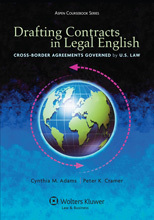Description
Drafting Contracts in Legal English
Cross-Border Agreements Governed by U.S. Law
Authors: Adams Cynthia M., Cramer Peter K.
Language: English
Approximative price 126.87 €
In Print (Delivery period: 20 days).
Add to cart350 p. · Paperback
Description
/li>Contents
/li>Biography
/li>
Written in a deliberate and concise manner, devoid of United States colloquialisms, Drafting Contracts in Legal English: Cross-border Agreements Governed by U.S. Law is designed for classroom use as well as self-study. Teaching a strategic approach and sequential steps to drafting contracts, the text includes examples and exercises based on cross-border agreements such as distribution agreements, licensing, franchises and equipment leases. Special drafting issues in cross-border agreements are also considered: choice of language clauses, choice of forum clauses, indemnification provisions, force majeure clauses, counterpart clauses, international alternative dispute resolution clauses, and the choice to opt in or out of the CISG. By providing appropriate explanations of United States law, the text increases student comprehension as suggested drafting approaches are placed in legal context. This unique guide discusses the purpose of and provides drafting tips for contract parts, contract organization and formatting, basic contract provisions, letters of intent, and the craft of reviewing and revising contracts. End-of-chapter exercises test overall comprehension and apply drafting concepts presented in the chapter. To increase the non-native speakers’ lexical range, vocabulary is derived from a statistical analysis of thousands of authentic contracts. To help with contract sentence structures that are challenging for non-native speakers, syntax structures are based on comparison to databases with authentic contracts. A glossary of contract terms is based on frequency counts from thousands of authentic contracts and usage in text, contextualized and cross-referenced with most common collocations. The online Teacher’s Manual gives suggestions for in-class discussion and exercises, sample drafting assignments designed to simulate real-world drafting experiences, and sample syllabi.
Features of Drafting Contracts in Legal English: Cross-border Agreements Governed by U.S. Law:
- Written in a deliberate and concise manner, devoid of United States colloquialisms
- Designed for classroom use as well as self-study
- Teaches strategic approach and sequential steps to drafting contracts
- includes examples and exercises based on cross-border agreements:
- distribution agreements
- licensing
- franchises
- equipment leases
- considers special drafting issues in cross-border agreements:
- choice of language clauses
- choice of forum clauses
- indemnification provisions
- force majeure clauses
- counterpart clauses
- international alternative dispute resolution clauses
- opting in or out of the CISG
- provides appropriate explanations of United States law:
- increases comprehension
- places suggested drafting approaches in legal context
- discusses the purpose of and provides drafting tips for:
- contract parts
- contract organization and formatting
- basic contract provisions
- letters of intent
- reviewing and revising contracts
- End-of-chapter exercises:
- test overall comprehension
- apply drafting concepts presented in the chapter
- build vocabulary:
- derived from a statistical analysis of thousands of authentic contracts
- increase non-native speakers’ lexical range
- clarify syntax:
- based on comparison to database with authentic contracts
- teach contract sentence structures that are challenging for non-native speakers
- Glossary of contract terms:
- based on frequency counts from thousands of authentic contracts and usage in text
- Contextualized and cross-referenced with most common collocations
- Online Teacher’s Manual:
- suggestions for in-class discussion and exercises
- sample drafting assignments designed to simulate real-world drafting experiences
- sample syllabi
Chapter One: Introduction
Chapter Two: Preliminary Drafting Concerns
Chapter
Three: Contract Structure
Chapter Four: Defined Terms
Chapter
Five: The Beginning of the Contract
Chapter Six: The Importance of
Clear and Concise Writing
Chapter Seven: Basic Categories of Contract
Provisions
Chapter Eight: Word Choice
Chapter Nine: Sentence
Structure
Chapter Ten: Core Provisions
Chapter Eleven: Exit
Provisions
Chapter Twelve: Alternative Dispute Resolution Provisions
Chapter
Thirteen: Miscellaneous Provisions
Chapter Fourteen: The End of the
Contract
Appendices
Cynthia M. Adams is Clinical Professor of Law and Co-Director of the Latin American Law Program at Indiana University School of Law-Indianapolis. She serves as the Chair-Elect for the American Association of Law Schools (AALS) Section on Graduate Programs for Foreign Lawyers and serves on the Executive Committee of the AALS Section on International Exchange Programs. She is a member of the Legal Writing Institute and serves as the Chairperson of the Legal Writing Institute’s Committee on Global Legal Writing Skills. Adams was one of the first faculty members to receive Indiana University's Trustee's Teaching Award in recognition of teaching excellence and is a three-time recipient of the law school’s Teaching Excellence Recognition Award. Previously, Adams practiced law with an Indianapolis law firm. She also served as an adjunct professor of English at Indiana University/Purdue University-Indianapolis and as an adjunct professor of English at Butler University.
Before joining the law school, Peter K. Cramer served as adjunct professor and associate director of Georgetown University Law School’s Center for Global Legal English. He also was a faculty instructor at Indiana University, Bloomington’s Center for English Language Training.
Previously, Cramer was an instructor and adjunct professor at Indiana University, Indianapolis School of Law, where he taught Integrated Legal Analysis & Contracts through IU’s program in Cairo, Egypt. Additionally, he has taught Intensive Communication in Business at Harvard University’s Institute for English Language Programs.
Cramer studied law in Germany and received a B.A. in 1989 from Ludwig Maximilian’s University in Munich. He then pursued his advance degrees at Indiana University, Bloomington, where he received his M.A. in applied linguistics in 1992, Ph.D. in language education in 1997, and LL.M. in 2006. He also studied Japanese philology in 1993 at Humboldt University in Berlin, Germany.




